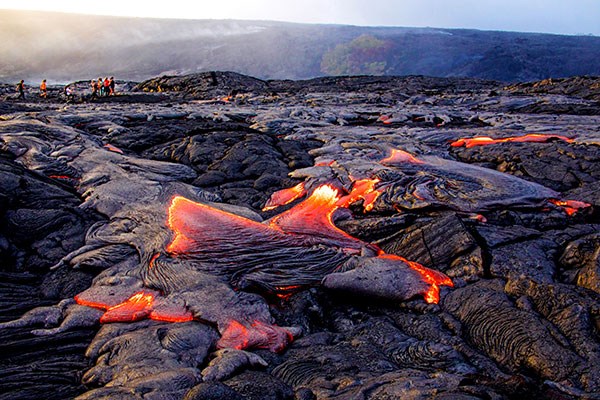Kilauea Volcano Erupts, Displacing Hawaiians

May 17, 2018
Two weeks ago, Hawaii’s Kilauea volcano erupted, sending residents fleeing for safety as the molten lava flowed towards residential areas. The known active volcano last erupted in 2014. The most recent eruption, however, was coupled with dozens of earthquakes that occured within the timespan of only 24 hours. As a result, volcanic vents have opened across nearby towns, putting more areas at risk. As thousands of people continue to evacuate, due to the lava and the toxic fumes caused by the eruption, officials say “volcanic activity shows little sign of slowing down.”
Kilauea has shown its power in the past, with an explosion in 1952 that lasted for 136 days, and another eruption in 1959 that shot lava 1,900 feet into the air. Therefore, nearby residents have always been wary of the one of the most active volcanoes in Hawaii. Scientists had been closely watching signs of increased activity underneath the volcano, due to the rise in magma. Observing the earthquakes shaking the Big Island, they quickly realized that the residents at the East Rift, not the crater-visiting tourists, were in danger. They quickly informed the residents but, however informed the volcanists were, the eruption was still hard to prepare for because there hadn’t been an explosion on the East Rift Zone in decades. Now the residents have to escape the trifecta of volcanic danger: lava, earthquakes, and sulfur dioxide, along with the slight possibility of a tsunami.
Although lava moves very slowly, it is so hot that it can ignite things before it even touches them. Since vents are randomly opening as the plates shift, no one knows what place will be victim next. Lava had already reached the East Rift Zone, putting 700 homes in the evacuation zone, and harming the electrical and water systems nearby. While the vents have slightly quieted, allowing for more people to escape, officials are still wary of future explosions or earthquakes that could mess up the delicate peace.
Along with the lava flowing into cities, the lethal concentration of sulfur dioxide is the main thing that caused a quick mandatory evacuation minutes after the eruption. The gas affected first responders, who reported getting headaches and feeling sick after their shift ended. First responders urge those who would be the most affected, such as seniors or children, to be vigilant and to cover their mouths when evacuating. Volcanologists are also continuing to monitor the seafloor near the island, trying to spot a significant change in the sea floor. Although there is only a small chance of a tsunami, they hope to prevent a repeat of the 2011 tsunami, which devastated Hawaii after striking Japan, and caused tens of millions of dollars in damage.
As residents evacuate, they are forced to leave behind everything they worked up to — houses, family pictures, and prized possessions. Community centers are providing shelters for the displaced people. Residents are forced to question their future and security, because they don’t know when their lives will return to normal. It’s possible that this explosion could only last a few more days, or a few more months. Families will now have to rebuild, possibly in a new area, and hope that there will be no more upcoming eruptions in future years. Since there are six active volcanoes making up the group of islands, no one really knows when or who the magma will victimize next, and all they can do is quickly evacuate when the news of their crumbling world reaches them.
Recently, the volcano’s force has only worsened, shooting ash 12,000 feet into the air, and forcing the U.S Geographical Survey to issue a “code red” for the island. Although they don’t know what caused this spike in activity yet, geologists are taking precautions with the surrounding areas. Air restrictions have been put into place and volcanologists are warning residents about the dangerous amounts of ash and sulfur particles, known as vog, in the air. They are also informing residents about an explosion that could occur if the lava continues to go down near the crater, which would send enormous rocks flying. Although no deaths or injuries have been reported yet, officials are urging those in the affected area to be vigilant and careful.


